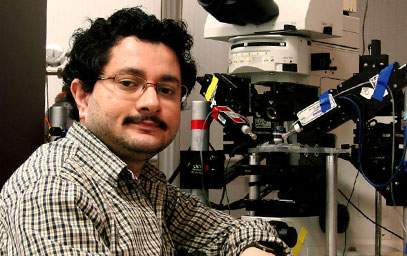
By Rolando Garcia
Natural Sciences and Mathematics
A University of Houston biochemistry graduate student received a prestigious fellowship to pursue pioneering neuroscience research that could one day yield new treatments for epilepsy patients.
Anupam Hazra, a Ph.D. student in biochemistry, recently received a one-year, $20,000 fellowship from the Epilepsy Foundation – one of only a dozen such fellowships the Foundation awards annually.
Epilepsy is a neurological disorder characterized by recurrent, spontaneous seizures and affects about 50 million people worldwide. In epileptic patients, abnormally synchronized neurons produce repetitive activity called synchronous bursts and seizures. These processes usually initiate in a small area and have an ability to spread throughout the brain.
Hazra works under Jokūbas Žiburkus, an assistant professor of biology and biochemistry who is studying the cellular and network mechanisms underlying activity in normal and pathological neural networks. Specifically, the lab is interested in how endogenous substances released by the brain, such as norepinephrine, regulate neural network dynamics.
A major complicating factor in efficient treatment of epilepsy is that about a quarter to a third of patients with epilepsy do not respond to currently available antiepileptic drugs and continue to suffer from uncontrollable seizures. Several neurodegenerative disorders are linked to the changes in levels of the endogenous neuromodulators, so scientists are seeking to better understand how these neuromodulators can regulate normal neural networks and the abnormal epileptiform activity on a multi-scale level: individual cells, neural microcircuits, and extended brain networks.
Hazra’s fellowship work is concentrating on the role of a specific endogenous modulator receptor, the beta adrenergic receptor. The activation of these receptors in epileptic patients is thought to be anti-convulsant. Using a multidisciplinary approach that utilizes cutting-edge techniques of fast imaging and concurrent electrophysiology along with sophisticated computational analysis tools, Hazra hopes to explain the underlying cellular mechanisms that cause the formation and spread of the synchronized epileptic bursts in the brain tissue.
Hazra’s preliminary work from this fellowship already shows promising results suggesting that synchronized bursts and seizures can be abrogated by beta adrenergic activation. Exploring these fundamental questions in greater depth could lead to more effective treatments for patients with drug-resistant epilepsy where norepinephrine may be anti-convulsant.
Hazra, a native of India who earned his bachelor’s and master’s degree in Microbiology, worked several years as a researcher in the biotechnology division for Wockhardt Ltd., a global pharmaceutical and biotechnology company based in Mumbai. Seeking to advance in research and pursue a doctorate, Hazra was attracted to the opportunities for translational neuroscience research at UH.
He will graduate this fall and hopes to continue his work in neuroscience. Hazra is planning to pursue postdoctoral training in the field of neurodegenerative disease research with the hope of developing novel therapeutic interventions. |

